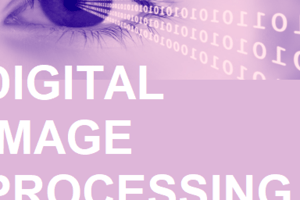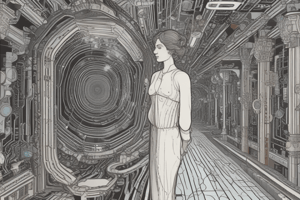Podcast
Questions and Answers
Which of the following is NOT typically considered a type of feature used in image recognition?
Which of the following is NOT typically considered a type of feature used in image recognition?
- Edges
- File size (correct)
- Textures
- Colors
In the context of pattern recognition, what is the primary purpose of the 'testing set'?
In the context of pattern recognition, what is the primary purpose of the 'testing set'?
- To provide the model with labeled examples for learning.
- To train the model initially.
- To fine-tune the model's parameters during training.
- To evaluate the performance of a trained model on unseen data. (correct)
Which machine learning approach does k-Means clustering belong to?
Which machine learning approach does k-Means clustering belong to?
- Reinforcement Learning
- Supervised Learning
- Semi-supervised Learning
- Unsupervised Learning (correct)
Which of the following is a key characteristic that distinguishes Convolutional Neural Networks (CNNs) from other neural networks in image processing?
Which of the following is a key characteristic that distinguishes Convolutional Neural Networks (CNNs) from other neural networks in image processing?
In image pattern recognition, what is the role of 'features'?
In image pattern recognition, what is the role of 'features'?
What is the purpose of the training phase in pattern recognition?
What is the purpose of the training phase in pattern recognition?
Which of the following pattern recognition approaches involves comparing image segments with predefined templates to find matches?
Which of the following pattern recognition approaches involves comparing image segments with predefined templates to find matches?
Which of the following is an application of Convolutional Neural Networks (CNNs)?
Which of the following is an application of Convolutional Neural Networks (CNNs)?
Which of these applications demonstrates the use of Recurrent Neural Networks (RNNs) in processing sequential image data?
Which of these applications demonstrates the use of Recurrent Neural Networks (RNNs) in processing sequential image data?
In the context of autonomous vehicles, how does object detection and recognition, an application of pattern recognition (PR), primarily contribute to the vehicle's functionality?
In the context of autonomous vehicles, how does object detection and recognition, an application of pattern recognition (PR), primarily contribute to the vehicle's functionality?
How does multimodal pattern recognition enhance the accuracy of recognition systems compared to systems that rely on a single data source?
How does multimodal pattern recognition enhance the accuracy of recognition systems compared to systems that rely on a single data source?
What is the primary advantage of using transfer learning and domain adaptation in pattern recognition?
What is the primary advantage of using transfer learning and domain adaptation in pattern recognition?
In what way does integrating machine learning techniques with deep learning models enhance pattern recognition systems?
In what way does integrating machine learning techniques with deep learning models enhance pattern recognition systems?
Flashcards
Recurrent Neural Networks (RNNs)
Recurrent Neural Networks (RNNs)
Neural networks designed for sequential data, like time series or video.
Facial Recognition
Facial Recognition
Identifying individuals from images or videos.
Object Detection and Recognition
Object Detection and Recognition
Locating and categorizing objects within an image.
Medical Image Analysis
Medical Image Analysis
Signup and view all the flashcards
Multimodal Pattern Recognition
Multimodal Pattern Recognition
Signup and view all the flashcards
Pattern Recognition in Images
Pattern Recognition in Images
Signup and view all the flashcards
Patterns
Patterns
Signup and view all the flashcards
Features
Features
Signup and view all the flashcards
Classification
Classification
Signup and view all the flashcards
Training (in Pattern Recognition)
Training (in Pattern Recognition)
Signup and view all the flashcards
Testing (in Pattern Recognition)
Testing (in Pattern Recognition)
Signup and view all the flashcards
Traditional Pattern Recognition
Traditional Pattern Recognition
Signup and view all the flashcards
Convolutional Neural Networks (CNNs)
Convolutional Neural Networks (CNNs)
Signup and view all the flashcards
Study Notes
- Pattern recognition in images is a field of computer vision and AI.
- Pattern recognition involves identifying and categorizing patterns in visual data.
- Facial recognition, object detection, and medical image analysis are some of the fundamental tasks that pattern recognition is used for.
Detailed Concepts
- Patterns are sets of data showing regularity or structure, such as shapes in images or sounds in speech.
- Features are measurable properties observed in a phenomenon, such as edges, textures, and colors in images.
- Features can also be frequency components of sound signals in speech recognition.
- Classification means assigning a category or label to new data.
- Classification is based on a training dataset with known categories and relies on features extracted from patterns.
- During training, a model is built by learning from a dataset with known correct outputs or class labels - "training set".
- During testing, the trained model is evaluated using a separate "testing set" that contains new, unseen by the model, data.
Pattern Recognition Approaches
- Pattern recognition approaches identify and categorize patterns in visual data.
- Pattern recognition approaches are broadly divided into traditional methods and modern machine/deep learning methods.
Traditional Approaches
- Traditional approaches involve comparing image segments with predefined templates to find matches.
Machine Learning Approaches
- Supervised learning, such as Support Vector Machines (SVM), k-Nearest Neighbors (k-NN), Decision Trees, and Random Forests classifiers.
- Unsupervised Learning, such as k-Means Clustering and Hierarchical Clustering approaches.
Deep Learning Approaches
- Convolutional Neural Networks (CNNs) are specialized neural networks.
- CNNs process grid-like data, like images.
- CNNs feature convolutional layers to automatically learn spatial hierarchies of features.
- CNN architectures consist of convolutional, pooling, and fully connected layers.
- CNNs facilitate image classification, object detection, and facial recognition.
- Recurrent Neural Networks (RNNs) are suitable for sequential data.
- RNNs can be used for time-series or sequence data in images, such as video processing with Long Short-Term Memory (LSTM).
Examples of Pattern Recognition
- Pattern Recognition identifies and categorizes visual patterns.
- Facial recognition identifies and verifies individuals in real-time in public and private spaces for security/surveillance.
- Object detection aids autonomous vehicles by detecting people, vehicles, road signs, and obstacles.
- Object detection enables robots to interact and manipulate objects in their environment.
- Medical imaging diagnoses tumors, fractures, and anomalies in X-rays, MRI, and CT scans.
- Fingerprint recognition unlocks devices and authenticate in security systems via biometrics.
- Iris Recognition enables high-security applications requiring robust identification via biometrics.
- Voice Recognition is used for access control and user authentication via biometrics.
Pattern Recognition Extensions
- Pattern recognition can be extended to enhance its capabilities and applications.
- Extensions may fuse technologies, improve algorithms, and expand into new domains.
- Multimodal Pattern Recognition combines data from multiple sources (images, text, audio) to improve recognition accuracy.
- Real-time Pattern Recognition develops systems that process and recognize patterns in real-time (essential for time-sensitive applications).
- Transfer Learning and Domain Adaptation adapts models trained on one dataset to perform well on different but related datasets (reducing the need for large labeled datasets).
- Integrating machine learning techniques with deep learning models.
Studying That Suits You
Use AI to generate personalized quizzes and flashcards to suit your learning preferences.




